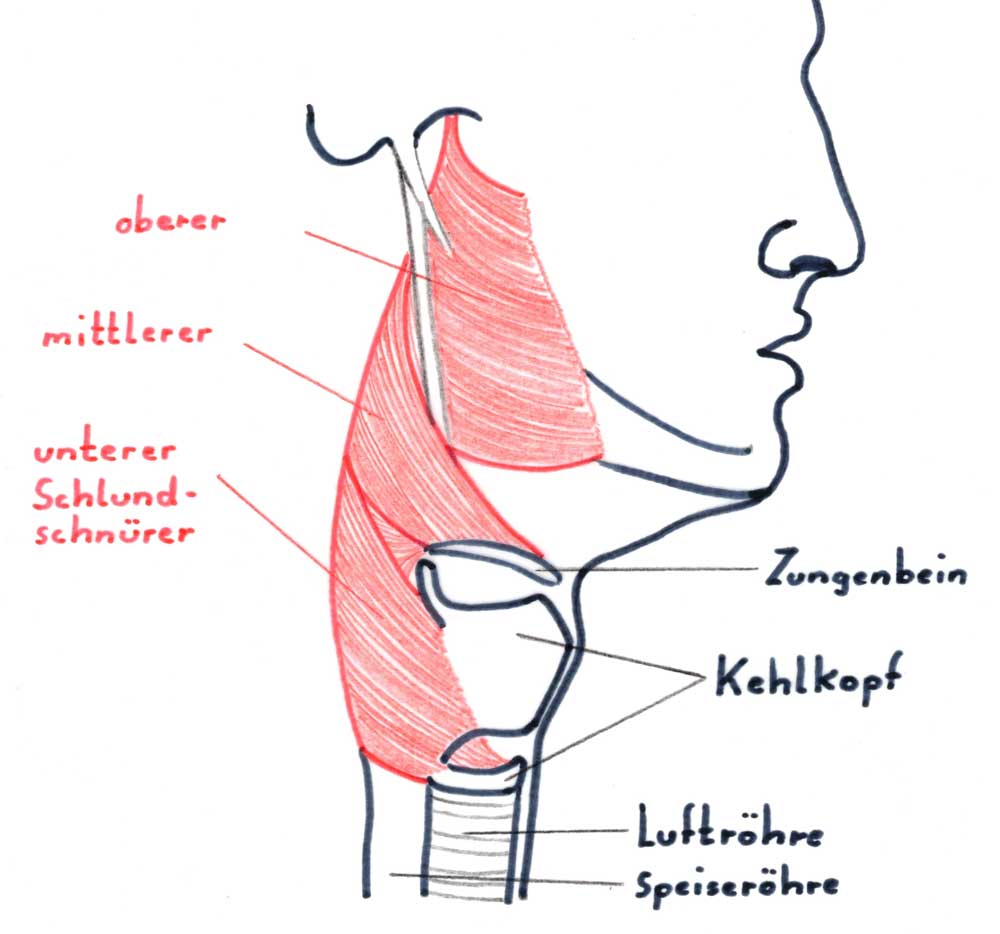There is a saying in vocal pedagogy: "The greatest enemy of the singer is the choke." Many people, beginners and aspiring singers alike, struggle with this: singing in the speaking register is pleasant, the voice sounds warm and full. The further up you go when singing, the tighter everything feels. The notes sound squeezed and shrill. It is as if your throat is constricting when you sing.
Singing with strangulation: musculature and typical signs
The feeling of tightness and constriction of the throat when singing has a very tangible basis. This is due to a muscle group that bears the martial but apt name "pharyngeal constrictor". These are large muscles that constrict the throat when swallowing and help to transport food into the oesophagus.

What few people realise: The same constricting muscles are also involved when feelings such as sadness, fear or anger arise in us. We then feel how it literally "constricts our throat". When a beginner sings an emotional part in a high voice, it is not uncommon for this muscular reflex to intervene. The result: their singing sounds tight and squeezed.
The unpleasant tightness is transmitted to the listener, and the beginner singer also feels it. Typical signs of singing with strangulation are: a feeling of choking when singing, a sore throat or neck when singing or speaking, early vocal fatigue or hoarseness, and the inability to "flip" from chest voice to head voice.
Fortunately, there are ways to outwit these constricting throat muscles. We would like to recommend three tried and tested exercises. They will help if you also have to deal with the issue of tightness in the throat.
Exercise 1: silent laughter
A simple way to help open up your throat is to adopt a silent laughter posture. Think of a funny situation that makes you smile, then laugh. Let your laughter swell into a loud "Ha-Ha-Ha". Next, imagine you are playing panomime and laughing without sound, but just as hard as before. Memorise this posture of silent laughter and how it feels.
Then smile, breathe in. Remember the posture of silent laughter and sigh. When sighing, for example, slide down over five notes (5-4-3-2-1), holding the last note a little longer. Use different vowels for this and go up and down in a pleasant pitch. Before you sing, always start with the feeling of quiet laughter that opens up your throat.
Exercise 2: utilising the energy of powerful speech
Be aware that when you sing in a high voice, for example "beltest"your larynx should feel no different than when you speak clearly and powerfully. Take a few short syllables, say them loudly, with high energy, but in a comfortable speaking voice: "A-ha!" or "O-ho!" like a birthday surprise, a joyful "Hello!", or "Oh yes!" in English.
Then sing (or shout) the syllables at the same volume in different pitches. Listen to the free, effortlessly powerful sound of your voice. And feel how your open throat feels - how different it is to singing when you are pressed. Then try to transfer this openness to your singing. It's best to do a few short vocalises or Vocal Runsbefore you go back to that song that made your throat tight.
Exercise 3: Head to the neck
And the best trick to prevent the constricting throat muscles from engaging: Tilt your head back. As already mentioned, these muscles are part of your swallowing muscles. Try looking up at the ceiling and try to swallow. You will find it very difficult to swallow because your swallowing muscles are so stretched with your head in your neck that they can hardly tense up.
Utilise this muscle weakness in the stretching position by leaning your head back and looking upwards while singing. This prevents the constricting muscles from interfering with your singing. As a result, your vocal apparatus "learns" (it is neuromuscular learning through repetition) to activate your vocal cords independently of the constricting swallowing muscles. In short: your throat becomes free again when you sing.
The best way to practise is to start with simple vowelises: for example, with the vowel A in small steps up and down (1-2-3-2-1). Don't put your head completely back, just as if you were drinking from a water bottle while exercising. In the same position, the drinking position, sing the song you are currently working on.
A tip to prevent stiff neck: Take a towel, stretch it behind your head and rest your head on it. If you find it difficult to hold the towel with the weight of your head the whole time you are standing, sit back in an armchair.
Voice effects without strangulation
The reflexive constriction of the throat by the swallowing muscles when singing is an evil, especially for aspiring singers. As important as it is to avoid this reflex, it would also be wrong to declare every use of the swallowing muscles when singing to be bad.
The so-called "Twang" is an example of this: a sound that gives the voice more sharpness and carrying power - a frequently used vocal quality in pop and soul singing, caused by a constriction of the throat. What's more, constricting throat and palate muscles are involved in many sharp, shrill or even growling vocal effects used by stars.
We therefore need to qualify the saying from the beginning: reflexively constricting the throat when singing at high pitch is "the enemy of the singer". However, when used consciously to express emotions, the constricting throat and palate muscles can be useful. Their use is then one of the many tools in the toolbox of experienced singers.
It is best to consult an experienced singing teacher if throat tightness is an issue for you. With expert support, you will find that once you have overcome the constriction of your throat, the unwanted tightness when singing, it is also fun to explore the many effects and expressive possibilities of your voice.
You can also find exercises for good posture, breathing technique and building your voice in my online courses.






